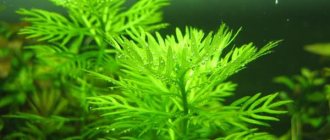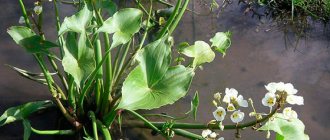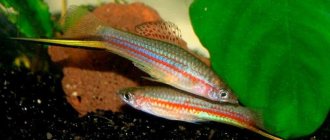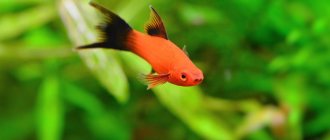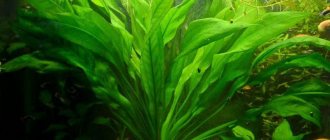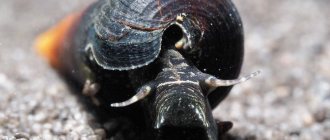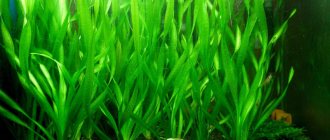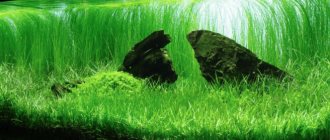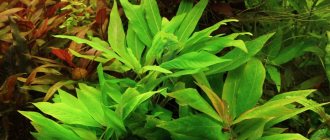The genus Myriophyllum, a member of the Haloragaceas family, currently contains about 45 species of freshwater aquatic plants with a cosmopolitan distribution. Its name comes from the Greek "myri" (too much to say) and "phyll" (leaf).
— Advertising —
The most popular species are included in the group of oxygenating aquarium plants, lakes and ponds, such as, for example, Myriophyllum aquaticum or Myriophyllum spicatum.
The rules for keeping and caring for cirrus as an aquarium plant are given in the contents of this article.
| Domain (Regio) | Eukaryotes _ |
| Kingdom (Regnum) | Plants (Plantae) |
| Type (Phylum) (division) | Flowering plants (Angiospermae) |
| Class (Сlassis) | Dicotyledons (Dicotyledones) |
| Squad (Ordo) (order) | Saxifragales _ |
| Family _ | Slateberry (Haloragaceae) |
| Genus _ | Cirrus (Myriophýllum) |
- 4.1 Reproduction methods
Botanical description
Plants: pinnate or urut or water perennial - perennial, aquatic herbs, monoecious or dioecious. The stem is soft, rhizomatous, and contains from one to many branches. Submerged leaves are 3- or 4-peaked, rarely alternate, pectinate, ovate or oblong in length. The emerging leaves are smaller, sometimes the uppermost ones are undivided, and are reduced to the bracts of the inflorescence. The inflorescence is usually an incipient terminal spike. The flowers are sessile, usually four-membered, small, the lower ones are female, the upper ones are male, the middle ones are bisexual. Male flowers: calyx deeply 2-4-lobed; petals 2-4, boat-shaped, often pink; stamens 2-8, epipetal. In female and bisexual flowers, the calyx tube is connected to the ovary; petals are small, often absent; stigmas 4, they are sessile, curved, pinnate.
Reproduction
Reproduction of the green Matogrossian pinnate occurs by vegetative means. To do this, you need to cut off the top part of the existing plant and plant it in the ground. Over time, it will take root and soon begin to grow.
If we talk about the financial side of the issue, then on the Internet, various sites selling pet supplies offer the described plant in the price range from 120 to 200 rubles per bush, which contains from three to five roots.
To summarize, it should be noted that the green cirrus matogrossii is a rare representative of aquarium plants, suitable for both beginner hobbyists and big professionals in the world of aquarium keeping. The combination of aesthetic splendor with tolerance for the possible conditions of the surrounding flora and fauna makes it one of the most attractive aquarium plant species that everyone should own.
Habitat
— Advertising —
Featherwort can be found in slow-moving freshwater lakes, ponds, streams, and ditches. It responds well to high nutrient content. The waterfinch grows in shallow water and moist soil along shorelines, so the species is adapted to moderate water fluctuations. Urut tolerates some salinity and is capable of colonizing brackish coastal waterways. The plant grows best in conditions where light penetrates to the bottom, but can occur as a floating species in the deep waters of lakes.
What should the water be like?
Cirrus roraima prefers:
- soft and clean water,
- her restrained and soft movement;
- absence of mechanical impurities (otherwise they get clogged in finely cut leaves and pose a threat of rotting);
- relatively warm temperature (20-27o);
- pH value is within 6-8.
In such conditions, the plant, like the red-stemmed pinnate, has a beautiful brownish color, grows wildly with leaves and looks beautiful both in the center of the aquarium (as a definite accent) and along its perimeter.
Varieties of featherfoil
Eurasian milfoil (Myriophyllum spicatum)
Myriophyllum spicatum grows two types of leaves. Submerged: 2-4 centimeters long, feather-shaped, arranged in 4 whorls around the stem. They are often square in shape and have more than 14 pairs of leaflets per leaf at the end. On mature plants, the leaves are closely clustered along the midrib. Emerging: tiny, 1-3 millimeters in length, smooth from edge to denticles. The stem is long, often abundantly branched, forming a reddish or olive-green “mat” in summer.
The flower is tiny. Female flowers are devoid of petals, while male flowers have 4 petals and 8 anthers. The fruits are up to 3 millimeters in diameter, divided into 4 chambers, containing 1 seed per chamber.
Eurasian milfoil is native to Eurasia and North Africa but is widespread in North America.
Habitat: lakes, rivers and ponds. Tolerates a wide range of climates and water conditions.
Siberian millennial (Myriophyllum sibiricum)
Other names: northern milfoil, northern water milfoil. The root of Myriophyllum sibiricum is fibrous and will grow from plant fragments. The leaves of two widows grow. The feather-like, olive-green submerged leaves are arranged in 3-4 whorls with less than 14 pairs of leaflets per leaf. Each leaf is up to 4 centimeters long. The pairs of leaflets at the base are much longer than the pairs at the tip, giving the millennial a spear shape. The emerging leaves are located under the flowers on the peduncle, they are tiny - from 1 to 3 millimeters in length. The stem is up to 3 meters, often reddish, and is usually visible through the widely spaced leaves. Female flowers have no petals; male flowers have 4 petals and 8 anthers. The fruits are nut-like, up to 3 millimeters in diameter, divided into 4 chambers, 1 seed per chamber.
Feather parrot (Myriophyllum aquaticum)
Parrotfeather is a rooted, perennial floating and emergent plant with low-growing stolons, fibrous roots and 5mm diameter stems that grow up to 2 meters in length. Feather-shaped blue-green leaves measuring 25-45 x 7-15 mm have 5-6 whorls, each of which is divided into 25-30 leaflets 7 mm long. Tiny, 0.5 millimeters, four white sepal flowers grow on short stems at the base of emerging leaves.
Parrotfeather is similar in appearance to bladderworts, hornworts and other leafy yarrows; however, its distinguishing feature is the stiff, finely divided, feather-like leaves that emerge.
Featherwort (Myriophyllum quitense)
The roots of the plant are numerous and whitish. Myriophyllum quitense grows two types of leaves. The submerged ones are feather-shaped and arranged in groups of 2-4 (sometimes 5) in the form of whorls around the stem. The leaves are 1.5-4 centimeters long and 2 centimeters wide, with 5-10 pairs of leaflets per leaf. The submerged leaves are located at the base of the stem, they are small, entire and opposite. Emerging leaves: blue-green to reddish-colored, growing in groups of 3-4 around the flower spike. Each is 0.5-1 centimeters long, oval to triangular in shape. The stem is cylindrical, 1-4 meters long and 2-4 millimeters in diameter. The tiny flowers, 0.7-1.2 millimeters long, have 4 sepals, 4 petals, and are located at the base of the emerging leaves. The male flowers grow near the top of the flower stem; female flowers near the base. Blooms in August and September; later than other aquatic pinnates.
The fruits are olive-brown, square, 1.7 millimeters long, and are rare.
Whorled pinnate (Myriophyllum verticillatum)
Submerged perennial. The stem is thick, up to 3 meters long, simple, rarely branched, glabrous. The leaves are 20-35 millimeters long, pinnate, segmented. The inflorescence is a spike, 10-30 centimeters long. Bracts are 10-25 millimeters long, the lower one is the most sterile. The flowers are sessile, the whorls have 4-5 bracts, the upper one is male, the lower one is female; bisexuals are between them. The seeds are elongated, 1.5 millimeters long, smooth.
Rules of care
Hornwort is an aquarium plant that is easy to maintain. The main maintenance measure will be periodic washing of the Christmas tree from contamination.
The stem is carefully removed from the water and placed under running water with a gentle stream. The plant is then returned to the aquarium.
Important! Since the stems of hornwort are very large, during the washing procedure you should be extremely careful not to break or damage them. If the plant does break, then its upper part can be replanted. Because hornwort can quickly form strong thickets that will interfere with the growth of other plants and the swimming of large fish, they will need to be thinned out. This procedure is done with scissors. At the same time, old plants are cut out.
You need to change the water in an aquarium where hornwort grows once a week. Add ¼ of the total volume of water that has been standing for at least a week.
Once it reaches the top of the water surface it will need to be cut back and replanted.
If any part of the plant falls off or breaks off, it must be removed from the aquarium in a timely manner to prevent rotting.
This aquarium grass does not require any other care.
Plant growing technology
Reproduction methods
Reproduction occurs by plant fragments or rhizomes. Germination from seeds is rare.
Featherfoil care
- Cirrus does well in partial shade or partial shade.
- The species can withstand cold water, but above 10 ° C.
- It can live directly in water, but prefers peaty soil rich in nutrients.
- If grown in a pot, then the urut needs to be constantly watered, the soil must not dry out.
- Cirrus plants do not need to be pruned, but their growth must be controlled, especially in an aquarium.
- The plant is not susceptible to pests and diseases.
Possible problems
Proper care of the plant ensures its growth and development. Violation of one of the habitat requirements can create problems and lead to the death of the Cirrus:
- Exposure to direct sunlight will encourage the rapid proliferation of brown algae. They will interfere with the correct formation of Uruti, reduce its attractiveness and can strangle the plant.
- Lack of light negatively affects development. The plant is exhausted and fades. Leaves fall.
- This is an excellent treat for some species of fish and snails, which readily eat varieties with small leaves.
What and where is it used for?
Myriophyllum is of economic importance for water filtration, as feed for pigs, ducks and fish, and for polishing wood. The pinnate plant is used medicinally to reduce fever and as an antidiarrheal agent.
Can form dense, completely monotypic stands that clog waterways, irrigation and drainage channels and can spoil the physical and chemical characteristics of the reservoir by shading and slowing water flow. This dense growth leads to the loss of native vegetation, potential flooding problems, and interferes with recreational activities including boating, fishing and swimming.
Decorative pond
- Go to page:
Decorative pond
- Quote
- Quote
- Quote
- Quote
Decorative pond
- Quote
- Quote
This pond is the second on the site. It is very young, shallow, filmy, located on a slight slope. Made by hand
-(link not found)- -(link not found)- -(link not found)-
And this pond is already experienced. He's 5. Already renovated. Crucian carp from the local reservoir live and winter in it. It is deeper, but also filmy.
-(link not found)- -(link not found)- -(link not found)-
Maybe someone will be interested
- Quote
- Quote
Igor, thank you for the topic, it’s very relevant. This season we are going to build 2 ponds, but our task is more complicated. A small pond (film) is connected through a stream (also covered with a film) with a large pond (we want this one without a film). Here is a link about ponds without film https://www.aqa.ru/forum/viewthread.php?tid=13828
A neighbor has a pond without a liner, 3 years - the flight is normal, the water fluctuates within 15-20 cm during the season, this suits us quite well. Since the small pond will not be deep, it cannot be done without a film. Do you think this design will work?
- Quote
- Quote
